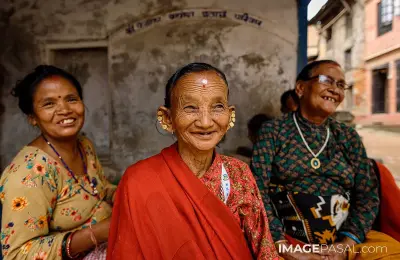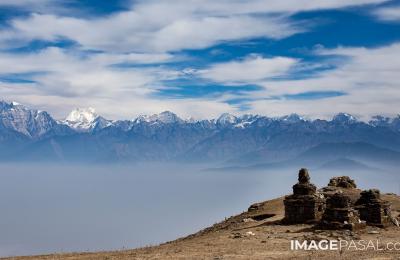For Hindu devotees, Maha Shivaratri, a Night devoted to Lord Shiva, is one of the most significant festivals. Lord Shiva, who has 108 different names, blue throat, wears Tiger’s skin and snakes as a necklace, and the powerful third eye, is one of the main deities in Hinduism. In terms of facts, every fourteenth day of the lunar month is known as Shivaratri, but the one in Falgun/March (Krishna Chaturdashi) is particularly significant, and hence it is known as “MahaShivaratri.” The literal translation of MahaShivaratri is “Shiva’s Great Night.”
Mythological Stories About Shivaratri
The origins of Shivaratri are shrouded in mystery. According to the first, Shivaratri relates to the celebration of Shiva and Parvati’s wedding day. Lord Vishnu is said to have officiated at the wedding as Parvati’s brother, with the creator-god Brahma serving as the wedding priest. Sages bestowed blessings on the couple.
According to the second mythology, Shivaratri is commemorated to honor Lord Shiva’s valiant act of consuming all of the blue poison collected from Samudra Manthan (Churning of Sea). Shiva was given the name BudhaNilkantha when his throat became blue as a result of consuming the poison.
According to another legend, Lord Brahma and Vishnu once fought over to claim the title of the greatest God. Lord Shiva advised both of them to find the end of a gigantic fire that raged throughout the universe. Vishnu and Brahma then raced to the fire’s end but were unable to discover any. Brahma, on the other hand, claimed to have discovered the end of the fire, which enraged Lord Shiva. He then denounced Brahma and said that he would never be revered. This day is also recognized as Shivaratri.
Story about Shivaratri Bratra as per ShivaPuran
Once King ChitraBhanu of India was fasting for Shivaratri. A sage happened to know this and asked him the reason behind fasting. He then elaborated on his past life and how fasting helped him get salvation. He was a hunter, named Suswara, in ancient life who was imprisoned for not paying debts on time. After being released, he went hunting, and during his hunting session, he didn’t kill any of his prey(deers), observed Jagran(staying awake all night), and unknowingly offered Bel leaves on Shivalinga. Although he had mistakenly observed fasting, Lord Shiva was delighted and blessed him, and in the next life, he became King ChitraBhanu.
Where do people go to observe Shivaratri in Nepal?
Every devotee of Lord Shiva in the world, including Nepal, visits nearby Shiva temples on Shivaratri. Pashupatinath Temple, one of the oldest Shiva temples, is the most crowded temple during Shivaratri, with pilgrims and Sadhus from all across Nepal and India.
Apart from Pashupati, the important Shiva pilgrimages on Maha Shivaratri are Pindeshwar( Sunsari), Halesi Mahadev (Khotang), Kusheshwar (Sindhuli), Jaleshwar Mahadev( Mahottari), Doleshwar and Ashapuri (Bhaktapur), Gokarneshwar Mahadev(Kathmandu), Santaneshwor Mahadev( Lalitpur), Gupteshwar (Kaski), Siddhababa(Palpa), Baidyanath Dham(Achham).
What do Nepali people do on Shivaratri?
The day of Shivaratri begins with a morning ceremonial bath, followed by Darsan of Lord Shiva at temples. Devotees offer milk, Panchamrit (milk, sugar, ghee, honey, curd), bananas, sandalwood paste, white and yellow flowers, bel leaves (stone apple), and other offerings. People chant Shiva-pleasing mantras, namely Om Namah Shivaya, ॐ नमः शिवाय), Om Namo Bhagurate Rudraayv (ॐ नमो भगवते रुद्राय नमः ), Om Tryambakam Yajamahe Sugandhim Pushh-Vardhanam Urvarukamiva Bandhanan Mdtyormukshiya Mamritat, (ॐ त्र्यम्बकं यजामहे सुगन्धिं पुष्टिवर्धनम् |उर्वारुकमिव बन्धनान्मृत्योर्मुक्षीय माऽमृतात्).
This day, the North Pole is oriented in such a way that it enables an incredible flow of energy in the living organisms in Nepal. People stay awake all night (Jagran) on Shivaratri to absorb spiritual power. To stay awake, people light a large fire, recite mantras, sing bhajans, and offer money into the fire to ask Shiva to fulfill their wishes during their Jagran. On this auspicious day, devotees also perform pooja and distribute food and money to Sadhus or beggars.
What do Photographers capture during Maha Shivaratri in Nepal?
Shivaratri in Nepal is an extremely devotional celebration; thus, for photographers taking photos during Shivaratri can be challenging. The best decision can be visiting the nearby temple or Pashupatinath Temple a night before Shivaratri to capture the decoration, vibrant preparation, and the early devotees’ excitement.
On the day of Shivaratri, you may take photos of Sadhus and Jogis with ash-covered or nude bodies. You may also take photographs of Sadhus surrounding the Dhuni (fire), smoking Marijuana bongs, or simply capturing their distinctive gestures or expressions. You may also capture devotees’ when staying in a queue or singing bhajan in the temple. You can also take photographs of scouts and volunteers handling queues/crowds, administering first aid, or carrying out their other duties.
Tips for Photographers
- Make sure you’re carrying your camera and other valuables in a secure bag.
- Do not photograph restricted locations.
- If you want to picture someone, always get their permission beforehand; don’t invade their privacy.
- You can click photographs with Sadhus. Offer money or other items in return for pictures.
- Drugs, in any form, should be avoided. Consume Prasads in less quantity.
- Bonus Tip- Try to capture something like a child or person dressed as Lord Shiva, concise use of offerings, cooperation between police or volunteers, or any other strikingly beautiful and connecting to people. Your photographs may go viral!!
Looking to Buy Images of Shivaratri in Nepal? If so, buy high-quality and enticing Shivaratri Photos from ImagePasal.com, Best Image Stock Company in Nepal.
We also have a large collection of photos of Nepal’s festivals, rare flora and fauna, cultures of Nepal, and many more.
Buy our digital images and printed photos for your artistic purposes, help to retain the country’s authenticity, and appreciate photographers for their effort.






